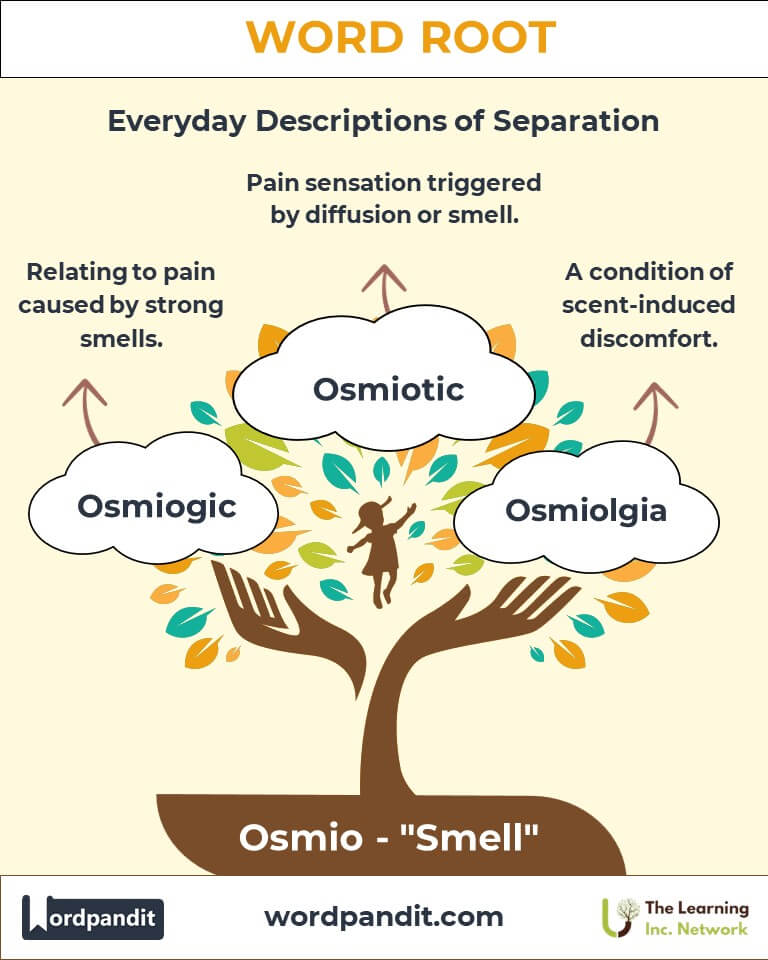Osmio: The Fragrant Root Shaping Science and Language
Discover the versatile root "osmio," derived from the Greek word "osme," meaning "smell" or "odor." This root enriches scientific and everyday terminology, bridging fields from chemistry to biology while adding depth to our understanding of scents and their implications.

Table of Contents
- Introduction: The Essence of Osmio
- Etymology and Historical Journey
- Mnemonic: Unlocking the Power of Osmio
- Common Osmio-Related Terms
- Osmio Through Time
- Osmio in Specialized Fields
- Illustrative Story: Osmio in Action
- Cultural Significance of Osmio
- The Osmio Family Tree
- FAQs About the Osmio Word Root
- Test Your Knowledge: Osmio Word Root Quiz
- Conclusion: The Fragrant Legacy of Osmio
Introduction: The Essence of Osmio
What connects the dense, metallic element osmium with the biological process of osmosis? The answer lies in the root "osmio," signifying "smell." Pronounced "oz-mee-oh," this root has shaped words that explore odors and diffusion, highlighting the sensory and scientific significance of scents.

Etymology and Historical Journey
The root "osmio" originates from the Greek word osme, meaning "odor" or "smell." Ancient Greek philosophers used "osme" to describe sensory experiences, linking it to perception and intuition. Later, in the 19th century, the term inspired the naming of osmium—a dense metal noted for its sharp smell in oxide form—and osmosis, the natural diffusion process fundamental to biology.
Mnemonic: Unlocking the Power of Osmio
To remember "osmio," think of a fragrant rose whose scent diffuses effortlessly through the air, symbolizing smell and movement.
Mnemonic Device:
"Think ‘osmio’ when odors flow."
Common Osmio-Related Terms
- Osmium (oz-mee-um):
Definition: A dense metallic element with a distinct, sharp odor when oxidized.
Example: "Osmium alloys are used in electrical contacts for their durability." - Osmosis (oz-moh-sis):
Definition: The movement of water through a membrane from a less concentrated solution to a more concentrated one.
Example: "Osmosis is vital in plant root absorption." - Osmoregulation (oz-mo-reg-yoo-lay-shun):
Definition: The process by which organisms regulate water and electrolyte balance.
Example: "Osmoregulation helps fish adapt to fresh or salt water." - Osmotic (oz-mot-ik):
Definition: Relating to or involving osmosis.
Example: "Osmotic pressure drives water movement in cells." - Osmophore (oz-muh-fohr):
Definition: A chemical group responsible for a compound’s smell.
Example: "The osmophore in jasmine gives the flower its iconic fragrance."
Osmio Through Time
- Osmium (1804): Discovered by Smithson Tennant, osmium was named for the pungent smell of its oxides.
- Osmosis (1854): Coined to describe a natural diffusion process essential to life, osmosis expanded our understanding of cellular mechanisms.
- Osmoregulation (20th Century): Introduced as biology advanced, emphasizing the root's enduring relevance in scientific innovation.
Osmio in Specialized Fields
- Chemistry:
Osmium: A platinum-group element notable for its odor and use in hardening alloys.
Application: It is critical in microscopy for staining biological samples. - Biology:
Osmosis and Osmoregulation: Key to cellular processes.
Example: Maintaining osmotic balance is crucial for survival in extreme environments. - Perfume Industry:
Osmophores: Define fragrance profiles, influencing perfume composition.
Application: They shape aromatic experiences, from floral to spicy scents. - Environmental Science:
Osmotic Filtration: Used in water purification.
Example: Reverse osmosis systems remove impurities for clean drinking water.
Illustrative Story: Osmio in Action
Lila, a chemist, studied the impact of osmotic pressure on plant growth. Her team developed a biodegradable membrane that enhanced water absorption in arid regions. Inspired by osmium’s strength, they named their invention “OsmoFlex.” With each breakthrough, Lila reflected on how the root "osmio" symbolized not just smell but the flow of innovation.
Cultural Significance of Osmio
From ancient Greek incense rituals to modern perfumes, scents shaped by osmio-related concepts evoke memories and emotions. Similarly, osmosis symbolizes natural balance, making osmio a metaphor for harmony and flow across cultures.

The Osmio Family Tree
- Osme- (Greek: Smell):
- Osmophore: Scent-producing chemical group.
- Osmology: Study of smells.
- Perfume Roots:
- Arom-: Relating to aroma (e.g., aromatic).
- Odor-: Latin root for smell (e.g., odoriferous).
- Hydro- (Greek: Water):
- Hydroosmosis: Osmotic movement in aquatic systems.
FAQs About the Osmio Word Root
Q: What does the root "osmio" mean?
A: The root "osmio" originates from the Greek word osme, meaning "smell" or "odor." It captures the concept of scent and plays a central role in scientific terms related to smell and diffusion, like osmium and osmosis.
Q: Why is osmium named after "osme"?
A: Osmium, a dense metallic element, was named for the sharp, pungent smell of its oxides, which were notable when the element was first isolated. This connection to smell ties its name to the root "osmio."
Q: What is osmosis, and why is it important?
A: Osmosis refers to the movement of water molecules through a semipermeable membrane from an area of lower solute concentration to an area of higher solute concentration. It’s essential for many biological processes, such as nutrient absorption in plants and maintaining cellular hydration in animals.
Q: How does osmosis differ from diffusion?
A: While both involve the movement of particles, osmosis specifically refers to the movement of water across a semipermeable membrane. Diffusion is a broader process where particles move from areas of high concentration to low concentration without needing a membrane.
Q: What is osmoregulation?
A: Osmoregulation is the biological process that organisms use to maintain a stable balance of water and electrolytes (such as salts) in their bodies. This process is vital for survival, especially in organisms that live in extreme environments like freshwater or saltwater habitats.
Q: What is an osmophore?
A: An osmophore is a chemical structure or functional group within a molecule responsible for its smell. For example, the fragrance of flowers often results from osmophores that produce aromatic compounds.
Q: How is the root "osmio" relevant to water purification?
A: The principle of osmosis is the foundation for reverse osmosis systems used in water purification. These systems force water through a semipermeable membrane to remove impurities and produce clean drinking water.
Test Your Knowledge: Osmio Word Root Quiz
1. What does the root "osmio" signify?
2. What is osmosis?
3. Why is osmium named after "osme"?
4. Which of the following describes osmotic pressure?
5. What is an osmophore?
Conclusion: The Fragrant Legacy of Osmio
The root "osmio" bridges the sensory and scientific, linking smell to pivotal discoveries like osmosis and osmium. Its applications span chemistry, biology, and beyond, reminding us of the profound connections between our senses and the natural world. As technology and science evolve, "osmio" will continue to shape our understanding of the flow and fragrance of life.












